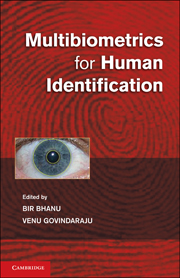Book contents
- Frontmatter
- Contents
- List of Contributors
- Preface
- Introduction
- PART I MULTIMODAL AND MULTISENSOR BIOMETRIC SYSTEMS
- PART II FUSION METHODS IN MULTIBIOMETRIC SYSTEMS
- 5 Biometric Authentication: A Copula-Based Approach
- 6 An Investigation into Feature-Level Fusion of Face and Fingerprint Biometrics
- 7 Adaptive Multibiometric Systems
- PART III HYBRID BIOMETRIC SYSTEMS
- PART IV DATABASES AND SECURITY
- PART V PERFORMANCE OF MULTIBIOMETRIC SYSTEMS
- Plate section
7 - Adaptive Multibiometric Systems
from PART II - FUSION METHODS IN MULTIBIOMETRIC SYSTEMS
Published online by Cambridge University Press: 25 October 2011
- Frontmatter
- Contents
- List of Contributors
- Preface
- Introduction
- PART I MULTIMODAL AND MULTISENSOR BIOMETRIC SYSTEMS
- PART II FUSION METHODS IN MULTIBIOMETRIC SYSTEMS
- 5 Biometric Authentication: A Copula-Based Approach
- 6 An Investigation into Feature-Level Fusion of Face and Fingerprint Biometrics
- 7 Adaptive Multibiometric Systems
- PART III HYBRID BIOMETRIC SYSTEMS
- PART IV DATABASES AND SECURITY
- PART V PERFORMANCE OF MULTIBIOMETRIC SYSTEMS
- Plate section
Summary
Introduction
Personal identification and verification by using biometric traits, such as finger-prints and faces, cover a large variety of applications. However, performance of current systems is still far from humans' (Sinha et al. 2006a, b).
The core of a biometric recognition system is the so-called enrollment stage. For each client, one or more biometric traits (e.g., a fingerprint and face images) are acquired and processed to represent it with a feature set (e.g., minutiae points). This feature set, labeled with the user's identity, is called a template and stored as a prototype of user's biometric trait in the system's database. The template is used in the recognition stage by comparing it with the input biometric(s), thus obtaining the so-called matching score, a real value into [0,1], which is the degree of similarity between the input sample and the given template.
As pointed out clearly in Uludag et al. (2004), in real operational scenarios, we have to handle substantial variations of each person's appearance. This large intraclass variability is due to changes of the environment conditions (e.g., illumination changes), aging of the biometric traits, variations of the interaction between the sensor and the individual (e.g., variations of the person pose), etc. Therefore, the enrolled templates could be poorly representative of the biometric data to be recognized, resulting in poor recognition performance.
- Type
- Chapter
- Information
- Multibiometrics for Human Identification , pp. 143 - 170Publisher: Cambridge University PressPrint publication year: 2011
- 1
- Cited by

